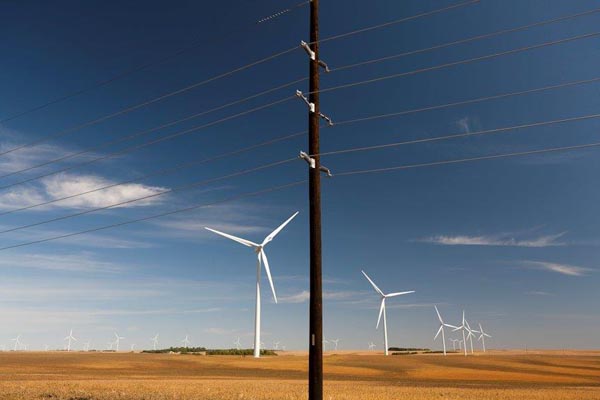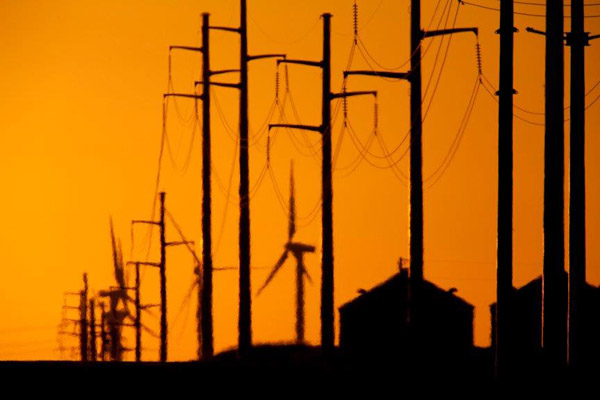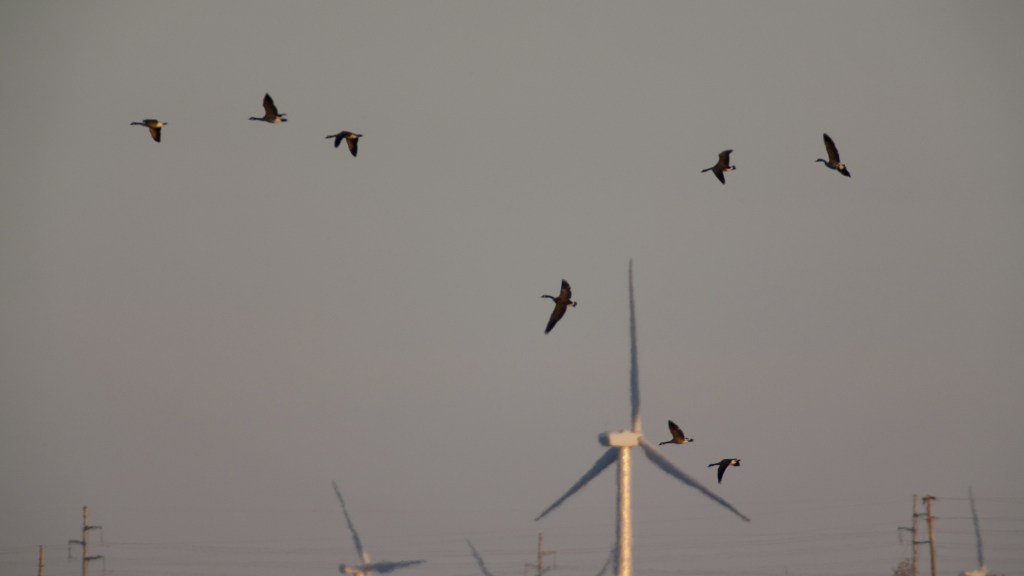The problem of birds being killed at wind power facilities continues to generate a lot of media attention.
Recent scientific, peer-reviewed studies are providing new and more detailed information on the extent of this problem, particularly compared to other sources of bird mortality such as cats and building collisions.
These studies provide valuable context for considering the issue of bird mortality related to wind turbines by confirming that turbines are not the leading cause of bird deaths.

But they should not be taken as a sign for conservationists and the wind industry to ignore the issue, especially considering the current pace and scale of wind energy development. Our society needs more low-carbon, renewable energy to help reduce greenhouse gas emissions and slow climate change, but it must be developed in ways that account for and minimize impacts such as wildlife mortality.
The negative effects of wind turbines on bird and bat populations and their habitats are serious and deserve continued study and attention.
The apparent overall low number of birds killed at wind turbines in comparison to other sources of bird mortality masks the fact that certain species are considerably more vulnerable to collision with wind turbines than others.
The most significant species in this regard is the Golden Eagle, an apex-level predator in much of the country whose population sizes are already low and declining.
Large numbers of these birds are being killed at wind power facilities — larger numbers than would be expected based on their overall abundance alone, especially in the western U.S.
The reasons for this are being studied (as are methods to reduce the number of eagles killed), but appear to have something to do with the areas in which turbines are built, the tendency for certain prey species to be attracted to wind facilities, and the eagles’ method of hunting; all of these expose eagles to higher risk of colliding with turbine blades.
In addition to the risks posed to specific bird species, data is rapidly accumulating that bats (the “other” group of winged creatures) are especially vulnerable to being killed at wind turbines.
The reasons are not completely clear, but many credible studies, particularly at wind power facilities in the Appalachian Mountains, document much higher rates of bat than bird mortality at the same turbines.
This concerns conservationists because bat populations are likely much lower than those of birds overall. White Nose Syndrome, which is a disease that afflicts some bat species and is causing rapid population declines in some areas, also increases the population-level risks to bats from direct mortality associated with wind turbines.
This tendency for wind turbines to contribute additive mortality to already existing sources may also be a challenge for many bird species.
Beyond the issue of direct mortality, the construction of wind turbines in places of high conservation value (similar to the construction of other energy infrastructure like solar farms or natural gas wells) can increase the loss and fragmentation of intact habitats, which are the top threats to biodiversity everywhere, including birds (for more info, see this article).
In fact, Conservancy scientists feel this is the primary potential conservation impact of wind turbine development, and we are actively working with the industry and regulators to address it.
In addition, many species of grassland birds (whose habitats tend to coincide with some of the best wind resources in the country) exhibit behavioral avoidance of tall structures. Therefore, even though the birds may not be killed outright, the presence of wind turbines effectively causes the loss of a lot of habitat for these birds.
This phenomenon is of great concern for at least two species either recently listed or being considered for listing under the Endangered Species Act: Lesser Prairie-Chicken and Greater Sage-Grouse.
Beyond these practical conservation concerns, there are both domestic and international legal obligations related to our avian heritage.
Most bird species in the U.S. are protected by the Migratory Bird Treaty Act; eagles are also protected by the Bald and Golden Eagle Protection Act and some birds are listed under the Endangered Species Act.
Therefore, the direct and indirect impacts of wind power development should raise serious legal concerns that do not appear to be fully addressed in many circumstances. The Conservancy urges all involved with the development of wind power in the U.S. to follow not only current federal rules, regulations and guidelines, but also the best practices offered by conservation organizations and the best science available.
The Conservancy is a strong supporter of wind energy and we believe that it can be developed in a fashion that avoids negative impacts to biodiversity and addresses the concerns for avian and bat mortality.





Build cages around the wind turbines such as those for house hold fans.
I’m all for clean electricity generation however, wind turbine farm deployment is only just starting. Hundreds of thousands of Turbine towers will be needed if the Wind Water Solar only Sierra club and Greenpeace environmental groups are successful. Coupled with the Smart Grid that needs to be built to manage all of the spinning generator we will have a crisscrossed web of power line poles and towers connecting all of the electricity farms needed in the Stanford WWS Only plan. We can decarbonize electricity but it’s best to look at real world examples and copy those. I pay attention to this site to get a little bit of energy reality : http://www.ElectricityMap. Org 24/7 charts and data on electrical grids around the planet. Download the app, I promise to learn something about electricity
Can you post your sources for your claims? Who has done the studies? And have the results been posted?
Any design has its pro and con. Wind Turbines are no exception. The design could always be done in such a way to minimize its con or negative impact. But, we need to first understand what the con is before we can fix it. In that regards, this is a very good article.
There is little discussion on the use of blade-free, or horizontal wind turbines – these do not kill birds/bats! There are many designs, some large, some small, some barrel-shaped, but the concept of blade-free wind is not part of the discussion. Thoughts?
Dave Mehlman states “The Conservancy is a strong supporter of wind energy and we believe that it can be developed in a fashion that avoids negative impacts…”.But Mr. Mehlman does not tell why ‘we’ believe this. Readers need to know the source of this belief, to be able to judge credibility of the statement. And, despite TNC’s disclaimer about views of TNC vs. author’s views, does the ‘we believe’ indicate that TNC agrees with Mr. Mehlman, that wind can avoid negative impacts?
I am glad that TNC has finally expressed some concern about the wildlife mortality associated with wind turbines. It was very disappointing that TNC, working with FWS, approved of the “voluntary guidelines” approach to wind energy rather than pushing for mandatory regulations supported by hundreds of bird and bat conservation organizations. This TNC support has only made it more difficult for other conservation groups to get the rational approach to wind energy that is so desperately needed, and we can only hope that TNC revises its position in this regard. Finally, regarding blade visibility, most bird conservationists are far more worried about night-time migration mortality of passerines and other species than just daytime raptor mortality, and blade visibility will do nothing to reduce that.
I’m disapointed to read the The nature Conservancy is a supporter of wind energy. I strongly believe these things are a blight on the environment and not just from a bird and bat mortality standpoint.
Here in eastern Colorado these things are sprouting up and are a serious visual eyesore as well as the many maintenence roads being destructive. I don’t understand why this huge increase in our footprint isn’t being criticized for the bad idea it is.
I have a strong feeling that if these things were being put in the rain forest or mountain valleys they wouldn’t be tolerated but on the plains it’s not only acceptable but encouraged.
In case you think I’m a proponent of the oil industry you’re wrong as I’m sure fracking will ultimately ruin much of our water supplies. It’s just that these ugly wind “farms” and large scale solar “gardens” are not the gentle environmentally friendly power sources they are made out to be.
To respond to Barry, a paper was recently published which includes a scientifically rigorous estimate of mortality caused by wind turbines in the U.S. I believe that this paper is not subject to any of the potential biases that Barry mentions and has been subject to peer review. The paper is:
Loss, S.R., T. Will, and P.P. Marra. 2013. Estimates of bird collision mortality at wind facilities in the contiguous United States. Biological Conservation 168:201–209.
A similar paper was published recently that estimates mortality at wind facilities in Canada. It is:
Zimmerling, J.R., A.C. Pomeroy, M.V. d’Entremont, and C.M. Francis. 2013. Canadian estimate of bird mortality due to collisions and direct habitat loss associated with wind turbine developments. Avian Conservation and Ecology 8(2):10.
Hello, Dave Mehlman here. To respond to Tracy’s question, yes some work has been done on blade coloration techniques. However, a big problem is that the blade tips move very fast, even though the rate of rotation is slow. Therefore, there is a pronounced “visual blur” of the tips, which probably makes them difficult, if not impossible, to be seen by a bird, regardless of any color or markings. Obviously, for nocturnal bats, color would not help.
Dave,
I believe “study” of birds and bats being killed is purposely obscured. I have followed this subject for years. The publishing of true studies are few and far between and mostly controlled by those people who are the most ardent supporters of wind power…what I would call idealists. In the state of Massachusetts there are no studies of the many wind turbines that exist there for what they are killing…as they are pushing hard to develop more and they don’t want to spoil the money flow…and the feel good nature. In the states of NJ and DE the studies by local audubon societies show about 80 bird and bats killed per year per turbine….many more than the fraud number of 1 or 2…including in NJ an endangered Peregrine Falcon of which there are only 25 breeding pair(that was the first year of operation), also a number of Osprey. In PA they are seeing about 25 bats killed per turbine, 25,000 in total with plans for 75000 killed every year. Ever see a building kill a bat? I don’t trust “the government” to give an honest assessment as most military and government complexes are some of the most polluted place in the country. Self policing doesn’t work! Sadly many who fancy themselves as environmentalists have swallow the development of solar and wind power hook, line and sinker and defend any and all development as positive as beautiful and green! I have read the studies that conclude cats, powerlines, cars, building all kill large number of birds and bats. Do you know who pushed these “studies” (they are more like guesses) through USFW…The American Wind Energy Association! Why, because it gives them cover and are wild guesses. The studies I have seen of Golden Eagles in California that were radio tracked showed wind turbines and their equipment were in fact the leading killer. Most industrial wind turbines are not studied for the creatures they are killing and when you ask for information…they hide it!
Insects gather on hilltops and so do wind turbines hence high bat mortalities? Need to find link between bat and blade.
Has anyone ever studied making the blades easier to see for birds? I think they were designed to blend in which is nice for people who don’t like looking at them but is there any data to suggest that it would do any good to add color or a stripe that they could see and not get mesmerized?
yes they have spent millions studying the blade colors and also sell the idea of radars stopping the blades, as much of the wind industry is about money and an appearance of doing something, these “solutions” don’t work! Wind Turbines first off operate around 25% of the claimed capacity! Money is better spent on geothermal pump, energy efficiency and conservation…only problem is the people proposing solutions are mostly looking to make money..so efficient solutions don’t leave enough gravy and the do gooder conferences aren’t as fund if the solutions are easy! For example on the President biggest fund raiser who was recently rewarded with an Ambassadorship to Ireland…made his money wind wind power! Electric companies love wind power…as they know they have to raise rates to build the wind turbines, solar plant, the infrastructure and the power generators that operate the 75% of the time the wind turbine or solar panel aren’t operating. They don’t want a solution that drops demand and lowers prices. Most environmentalists are being played bigger time, with the massive industrialization of our open space, for a power source that infrequently operates, that some claim they love to look at!
Reducing demand does not reduce prices. Our province has steadily cut demand but utility prices continue to rise because of ‘revenue shortfalls from less than anticipated consumption’.
Also I do not see you addressing the net impact of replacing gas and coal fired generators with wind. It may very well be that in the long run, the net result is less dead wildlife due to less pollution.
While there is certainly a risk with wind turbines, there is nothing to suggest it is more of a danger to the overall environment that any other methods. However, everything we do comes at a price. Unfortunately we end up painting wind energy with a broad brush when the real issue is location, not the device.